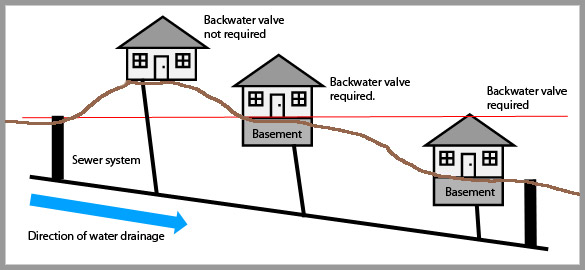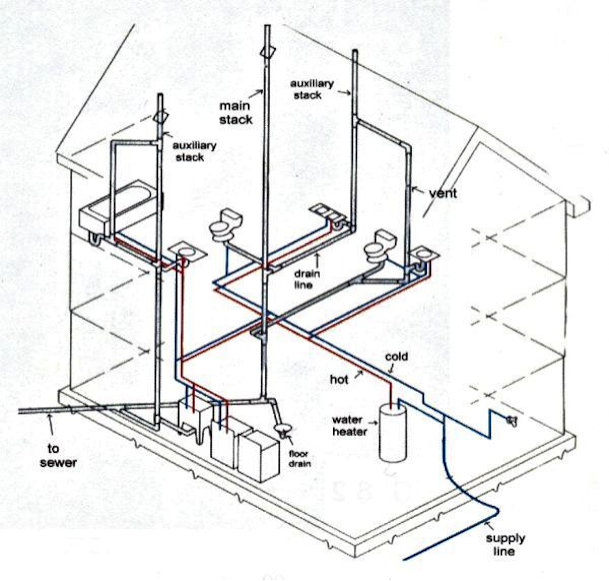A Closer Look at The Anatomy of Your House's Plumbing System
A Closer Look at The Anatomy of Your House's Plumbing System
Blog Article
The publisher is making several good pointers on The Inner Workings of Your Home's Plumbing as a whole in this post which follows.

Understanding just how your home's plumbing system works is essential for each property owner. From delivering tidy water for drinking, food preparation, and showering to securely eliminating wastewater, a well-maintained pipes system is important for your household's health and wellness and convenience. In this thorough overview, we'll check out the elaborate network that makes up your home's plumbing and deal ideas on maintenance, upgrades, and dealing with common problems.
Introduction
Your home's plumbing system is more than just a network of pipes; it's a complicated system that ensures you have access to clean water and efficient wastewater removal. Knowing its components and how they work together can help you avoid pricey fixings and make sure everything runs smoothly.
Basic Components of a Pipes System
Pipelines and Tubes
At the heart of your pipes system are the pipes and tubing that carry water throughout your home. These can be made of different products such as copper, PVC, or PEX, each with its benefits in terms of toughness and cost-effectiveness.
Components: Sinks, Toilets, Showers, etc.
Components like sinks, bathrooms, showers, and bath tubs are where water is made use of in your house. Recognizing just how these components attach to the pipes system helps in diagnosing problems and planning upgrades.
Valves and Shut-off Factors
Shutoffs regulate the flow of water in your plumbing system. Shut-off valves are important during emergencies or when you need to make repair work, enabling you to isolate parts of the system without interrupting water flow to the whole residence.
Water System
Key Water Line
The primary water line links your home to the community water supply or a private well. It's where water enters your home and is distributed to numerous components.
Water Meter and Stress Regulatory Authority
The water meter steps your water usage, while a pressure regulator makes certain that water moves at a risk-free pressure throughout your home's pipes system, stopping damages to pipelines and components.
Cold Water vs. Hot Water Lines
Understanding the distinction between cold water lines, which supply water directly from the main, and hot water lines, which carry heated water from the water heater, aids in repairing and preparing for upgrades.
Drain System
Drain Pipes Water Lines and Traps
Drain pipelines bring wastewater away from sinks, showers, and bathrooms to the drain or sewage-disposal tank. Traps avoid drain gases from entering your home and also trap debris that could create obstructions.
Ventilation Pipes
Ventilation pipelines permit air right into the water drainage system, stopping suction that might slow down drainage and cause catches to vacant. Correct air flow is vital for keeping the honesty of your plumbing system.
Value of Appropriate Water Drainage
Making certain correct water drainage protects against backups and water damage. Routinely cleaning drains pipes and keeping catches can stop expensive repair services and extend the life of your plumbing system.
Water Heating System
Types of Water Heaters
Hot water heater can be tankless or typical tank-style. Tankless heating systems warmth water as needed, while containers keep warmed water for instant use.
Upgrading Your Pipes System
Reasons for Upgrading
Updating to water-efficient components or replacing old pipes can improve water quality, lower water costs, and raise the worth of your home.
Modern Pipes Technologies and Their Advantages
Check out innovations like wise leak detectors, water-saving toilets, and energy-efficient hot water heater that can save money and reduce ecological effect.
Expense Considerations and ROI
Compute the ahead of time expenses versus long-term savings when taking into consideration pipes upgrades. Numerous upgrades pay for themselves with reduced energy costs and less fixings.
Just How Water Heaters Attach to the Pipes System
Comprehending exactly how water heaters link to both the cold water supply and hot water distribution lines helps in detecting concerns like insufficient hot water or leakages.
Maintenance Tips for Water Heaters
Frequently flushing your hot water heater to get rid of debris, inspecting the temperature settings, and evaluating for leakages can prolong its life expectancy and improve power performance.
Usual Pipes Problems
Leakages and Their Causes
Leaks can occur as a result of maturing pipes, loosened installations, or high water pressure. Addressing leakages immediately avoids water damages and mold growth.
Obstructions and Blockages
Obstructions in drains pipes and toilets are often brought on by flushing non-flushable items or a build-up of grease and hair. Using drainpipe screens and being mindful of what goes down your drains pipes can avoid clogs.
Indicators of Pipes Issues to Watch For
Low tide pressure, slow-moving drains, foul odors, or unusually high water costs are signs of possible plumbing troubles that should be attended to quickly.
Pipes Maintenance Tips
Routine Examinations and Checks
Arrange yearly plumbing examinations to catch concerns early. Search for indicators of leaks, deterioration, or mineral accumulation in taps and showerheads.
Do It Yourself Maintenance Tasks
Basic tasks like cleansing tap aerators, looking for bathroom leakages using color tablet computers, or shielding exposed pipelines in cold environments can protect against major plumbing concerns.
When to Call a Professional Plumbing Professional
Know when a pipes concern needs specialist knowledge. Trying complex repair work without correct knowledge can result in even more damages and higher repair expenses.
Tips for Lowering Water Usage
Easy practices like taking care of leakages promptly, taking shorter showers, and running complete lots of laundry and dishes can save water and reduced your energy costs.
Eco-Friendly Pipes Options
Take into consideration sustainable plumbing materials like bamboo for floor covering, which is durable and environment-friendly, or recycled glass for counter tops.
Emergency Readiness
Actions to Take Throughout a Plumbing Emergency
Know where your shut-off valves are located and exactly how to switch off the water in case of a ruptured pipeline or significant leakage.
Importance of Having Emergency Calls Convenient
Maintain call details for local plumbings or emergency services easily available for quick reaction during a plumbing crisis.
Environmental Impact and Conservation
Water-Saving Components and Devices
Mounting low-flow taps, showerheads, and commodes can dramatically minimize water use without compromising performance.
DIY Emergency Situation Fixes (When Relevant).
Short-lived solutions like making use of air duct tape to patch a leaking pipeline or positioning a bucket under a trickling faucet can minimize damages until a specialist plumbing technician arrives.
Conclusion.
Recognizing the composition of your home's plumbing system equips you to maintain it properly, saving money and time on repairs. By adhering to routine upkeep routines and remaining notified concerning contemporary pipes innovations, you can ensure your pipes system operates successfully for years to come.
HOW YOUR PLUMBING SYSTEM WORKS
Which Pipes Do What?
Blue lines = fresh water supply entering the building Red lines = hot water supply entering the building Grey lines = pipes carrying waste away from the building and venting pipes carrying gases away from the building (through the roof) YOUR MAIN PLUMBING SYSTEMS
There are two main plumbing systems that support your home s basic plumbing needs one that brings clean water into your home, and one that sends dirty water away from your home. Connected to the toilet, bath, shower, and other faucets in your home, these two systems keep your water flowing in the right directions.
ACCESSING FRESH WATER
Fresh and clean water is brought into your home through the main water supply line . Filtered through one pipe, this water is pressured to flow into the various fixtures in your home at any given time.
This water can be sourced from a well located on your property, a pond or river (mostly cottages), or, as in most cases, from the city s municipal water treatment centre. However, it is important to note that water that is untreated, such as the water siphoned from ponds or rivers, may not be safe to drink. Personal water supplies always need to be treated for hardness and contaminants before consumed.
MUNICIPAL WATER SUPPLIES
Improve taste and odour Remove sediment Eliminate hardness Reduce chlorine COLD WATER SUPPLY VS. HOT WATER SUPPLY
Cold water flows into your home or building through the service line, which then distributes hot or cold water to your fixtures. This line is most commonly run through a central column that runs floor to floor. Hot water runs in short and straight pipes as the longer the pipeline, the more heat that will be lost in the transfer. Having shorter pipes also allows residents to access hot water more quickly.
WASTE WATER SYSTEM
Your wastewater system is divided into two parts pipes that send wastewater away from your home and venting pipes that send sewer gas away from your home. Sewage water travels through pipes that flush the water and waste towards local sewers that are operated and managed by your city or town. Most sewer systems rely on gravity to move the wastewater to where it needs to go.
The further away from your toilet or sink, the larger wastewater pipes become. This allows for waste to be disposed of from various parts of your home or business at once without pipe blockages. The angle and flow of these pipes are also essential for keeping your waste pipes clear of build up.
https://harrisplumbing.ca/how-your-home-plumbing-system-works/

We had been shown that report on Anatomy of a House: Understanding the Components from a good friend on a different web address. Sharing is nice. Helping others is fun. Thanks so much for your time spent reading it.
Call Today Report this page